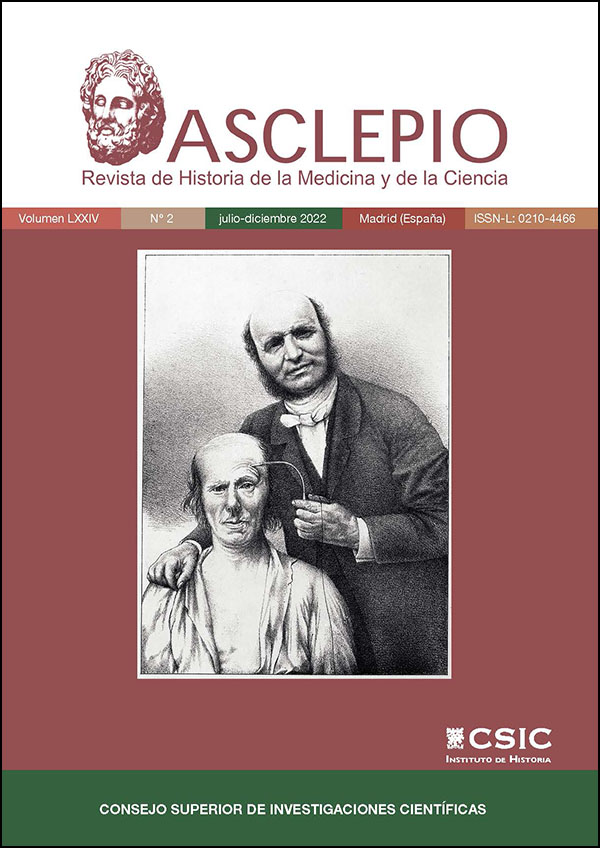Euclid’s in Practice: A treatise on Foundation and construction of Pantometers in 17th century Spain
DOI:
https://doi.org/10.3989/asclepio.2022.21Keywords:
Mathematical Instruments, Coignet-Type Sectors, Practical Geometry, 17th Century, SpainAbstract
At the beginning of the seventeenth century, the Jesuit Christoph Clavius (1537-1612) -a competent and well-known mathematician- began his Practical Geometry (Mainz, 1606) with two chapters devoted to the construction and use of two mathematical instruments. Thus, in addition to the common quadrant, an instrument for easily dividing any line into any number of equal or proportional parts, that he called Instrumentum Partium -later pantometer- became part of the academic mathematics teaching. This paper looks at a 17th-century Spanish unpublished anonymous manuscript -probably a course- on the construction and use of sectors from the viewpoint of its contribution to the development of the arithmetization of geometry by means of the numerical consideration of continuous magnitudes as quantities. The author bases the instrumental operability of sectors -that surpassed geometric methods or arithmetic calculations in terms of time and errors savings- on Euclid’s Elements, especially Book VI. As for incommensurability, the reduction of incommensurable quantities to the nearest commensurable quantities is accepted, for it is possible without noticeably error by the senses and irrelevant in practice.
Downloads
References
Ausejo, Elena (2022), "Using Euclid in a practical context: Claude Richard's course on sectors at the Jesuit Imperial College in 17th century Spain", LLULL, Revista de la Sociedad Española de Historia de las Ciencias y de las Técnicas, 45 (90), doi: 10.47101/llull.2022.45.90.ausejo [en espera de activación].
Bos, Henk J.M. (2001), Redefining Geometrical Exactness: Descartes Transformation of the Early Modern Concept of Construction, New York, Springer-Verlag.
Camerota, Filippo (2000), Il compasso di Fabrizio Mordente. Per la storia del compasso di proporzione, Firenze, Olschki.
Clavius, Christoph (1591), Euclidis Elementorum libri XV, Coloniae, Ioh. Baptistae Ciotti, [en línea], disponible en Google Libros, [consultado el 22/03/2021].
Clavius, Christoph (1606), Christophori Clavii Bambergensis e Societate Iesu Geometria practica, Moguntia, ex Typographeo Ioannis Albini, [en línea], disponible en: http://echo.mpiwg-berlin.mpg.de/MPIWG:DEWR2C0N, [URL permanente, consultado el 22/03/2021].
Coignet, Michiel (1618), El uso de las doze divisiones geometricas, puestas en las dos reglas pantometras, Manuscrito B 264708, Collectie Stad Antwerpen, Erfgoedbibliotheek Hendrik Conscience, [en línea], disponible en: https://dams.antwerpen.be/asset/ijFikoIe8gDjEXYeWf0whqBQ/j2hLXDnMXnKNPQZiggcGtmuY, [consultado el 22/03/2021].
Coignet, Michiel (1626), Géometrie reduite en une facile et briefve practique par deux excellens instrumens, Paris, Charles Hulpeau.
Connette, Michel (1626), La geometrie redvite en une facile et briefve practique, par deux excellens instruments, dont l'un est le pantometre ou compas de proportion de Michel Connette, Ingenieur du seu Serenissime Archiduc Albert, Paris, Hulpeau, [en línea], disponible en: http://echo.mpiwg-berlin.mpg.de/MPIWG:3SYMQ7HR, [URL permanente, consultado el 22/03/2021].
Descartes, René (1637), Discours de la méthode pour bien conduire sa raison et chercher la vérité dans les sciences, plus La dioptrique, Les météores et La géométrie qui sont des essais de cette méthode, A Leyde de l'imprimerie de Jan Maire, [en línea], disponible en: https://gallica.bnf.fr/ark:/12148/btv1b86069594, [consultado el 22/03/2021]. https://doi.org/10.1007/978-3-476-05728-0_9538-1 PMid:32812785
Drake, Stillman (1978), Galileo Galilei, Operations of the geometric and military compass, 1606. Translated, with an introduction by Stillman Drake, Washington D.C., Smithsonian Institution Press.
Heath, Thomas L. (1897), The Works of Archimedes, Cambridge, At University Press.
Heath, Thomas L. (1956), The thirteen books of Euclid's Elements translated from the text of Heiberg with introduction and commentary, New York, Dover Publications.
Joyce, David E. (1998), Euclid's Elements, Clark University, Department of Mathematics and Computer Science, [en línea], disponible en: https://mathcs.clarku.edu/~djoyce/java/elements/aboutText.html, [consulta 22/03/2021].
Malet, Antoni (1990), "Changing notions of proportionality in pre-modern mathematics". Asclepio, 42 (1), pp. 183-211. https://doi.org/10.3989/asclepio.1990.v42.1.574
Malet, Antoni (2006), "Renaissance notions of number and magnitude", Historia Mathematica, 33 (1), pp. 63-81. https://doi.org/10.1016/j.hm.2004.11.011
Meskens, Ad (2005), Joannes della Faille s. j. Mathematics, Modesty and Missed Opportunities, Brussel, Belgisch Historisch Instituut te Rome.
Meskens, Ad (2013), Practical mathematics in a commercial metropolis, Dordrecht, Springer. https://doi.org/10.1007/978-94-007-5721-9
Regiomontanus, Joannes (1534), Doctissimi ... Ioannis de Regio Monte De triangulis omnimodis libri quinque, Norimbergae, In aedibus Io. Petrei, [en línea], disponible en: https://bvpb.mcu.es/es/catalogo_imagenes/grupo.do?path=30162, [consulta 22/03/2021].
Sasaki, Chikara (2003), Descartes's Mathematical Thought, Springer Netherlands.
Van der Vyver, Omer (1977), "Lettres de J.Ch. della Faille, S.I., Cosmographe du roi à Madrid, à M.F. Van Langren, cosmographe du roi à Bruxelles, 1634-1645", Archivium Historicum Societatis Iesu, 46, pp. 73-183.
Zaragoza, José de (1675), Fabrica y uso de varios instrumentos mathematicos con que siruio al rey... Carlos Segundo en el dia de sus catorze años..., Madrid, Antonio Francisco de Zafra, [en línea], disponible en Biblioteca Digital Hispánica, [consultado el 22/03/2021].
Published
How to Cite
Issue
Section
License
Copyright (c) 2022 Consejo Superior de Investigaciones Científicas (CSIC)

This work is licensed under a Creative Commons Attribution 4.0 International License.
© CSIC. Manuscripts published in both the print and online versions of this journal are the property of the Consejo Superior de Investigaciones Científicas, and quoting this source is a requirement for any partial or full reproduction.
All contents of this electronic edition, except where otherwise noted, are distributed under a Creative Commons Attribution 4.0 International (CC BY 4.0) licence. You may read here the basic information and the legal text of the licence. The indication of the CC BY 4.0 licence must be expressly stated in this way when necessary.
Self-archiving in repositories, personal webpages or similar, of any version other than the final version of the work produced by the publisher, is not allowed.
Funding data
Ministerio de Economía y Competitividad
Grant numbers HAR2015-70985-P
European Regional Development Fund
Grant numbers HAR2015-70985-P
Universidad de Zaragoza
Grant numbers DGA H20_17R















